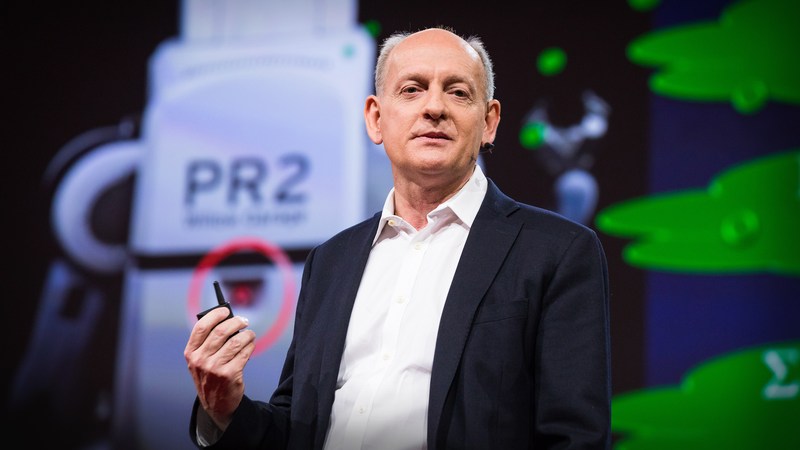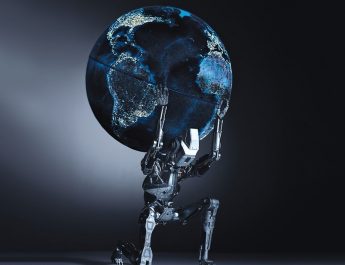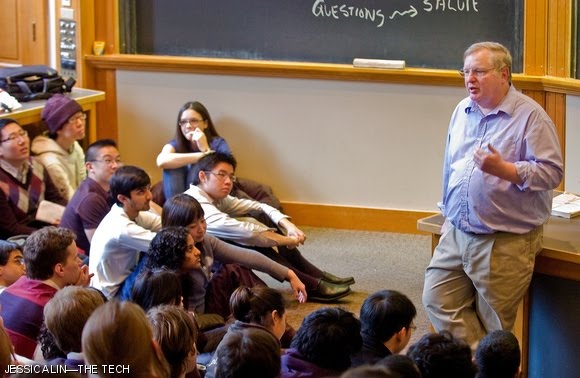How can we harness the power of superintelligent AI while also preventing the catastrophe of robotic takeover? As we move closer toward creating all-knowing machines, AI pioneer Stuart Russell is working on something a bit different: robots with uncertainty. Hear his vision for human-compatible AI that can solve problems using common sense, altruism and other human values.
“This is Lee Sedol. Lee Sedol is one of the world’s greatest Go players, and he’s having what my friends in Silicon Valley call a “Holy Cow” moment —a moment where we realize that Artificial Intelligence is actually progressing a lot faster than we expected. So humans have lost on the Go board. What about the real world?”
Well, the real world is much bigger, much more complicated than the Go board. It’s a lot less visible, but it’s still a decision problem. And if we think about some of the technologies that are coming down the pike … Noriko mentioned that reading is not yet happening in machines, at least with understanding. But that will happen, and when that happens, very soon afterwards, machines will have read everything that the human race has ever written. And that will enable machines, along with the ability to look further ahead than humans can, as we’ve already seen in Go, if they also have access to more information, they’ll be able to make better decisions in the real world than we can. So is that a good thing? Well, I hope so.
Our entire civilization, everything that we value, is based on our intelligence. And if we had access to a lot more intelligence, then there’s really no limit to what the human race can do. And I think this could be, as some people have described it, the biggest event in human history. So why are people saying things like this, that Artificial Intelligence might spell the end of the human race? Is this a new thing? Is it just Elon Musk and Bill Gates and Stephen Hawking?
Actually, no. This idea has been around for a while. Here’s a quotation: “Even if we could keep the machines in a subservient position, for instance, by turning off the power at strategic moments, we should, as a species, feel greatly humbled.” So who said this? This is Alan Turing in 1951. Alan Turing, as you know, is the father of computer science and in many ways, the father of AI as well. So if we think about this problem, the problem of creating something more intelligent than your own species, we might call this “the gorilla problem,” because gorillas’ ancestors did this a few million years ago, and now we can ask the gorillas:Was this a good idea?

So here they are having a meeting to discuss whether it was a good idea, and after a little while, they conclude, no, this was a terrible idea. Our species is in dire straits. In fact, you can see the existential sadness in their eyes.
So this queasy feeling that making something smarter than your own species is maybe not a good idea — what can we do about that? Well, really nothing, except stop doing AI, and because of all the benefits that I mentioned and because I’m an AI researcher, I’m not having that. I actually want to be able to keep doing AI.
So we actually need to nail down the problem a bit more. What exactly is the problem? Why is better AI possibly a catastrophe?
So here’s another quotation: “We had better be quite sure that the purpose put into the machine is the purpose which we really desire.” This was said by Norbert Wiener in 1960, shortly after he watched one of the very early learning systems learn to play checkers better than its creator. But this could equally have been said by King Midas. King Midas said, “I want everything I touch to turn to gold,” and he got exactly what he asked for. That was the purpose that he put into the machine, so to speak, and then his food and his drink and his relatives turned to gold and he died in misery and starvation. So we’ll call this “the King Midas problem” of stating an objective which is not, in fact, truly aligned with what we want. In modern terms, we call this “the value alignment problem.”
Putting in the wrong objective is not the only part of the problem. There’s another part. If you put an objective into a machine, even something as simple as, “Fetch the coffee,” the machine says to itself,“Well, how might I fail to fetch the coffee? Someone might switch me off. OK, I have to take steps to prevent that. I will disable my ‘off’ switch. I will do anything to defend myself against interference with this objective that I have been given.” So this single-minded pursuit in a very defensive mode of an objective that is, in fact, not aligned with the true objectives of the human race — that’s the problem that we face.And in fact, that’s the high-value takeaway from this talk. If you want to remember one thing, it’s that you can’t fetch the coffee if you’re dead.
It’s very simple. Just remember that. Repeat it to yourself three times a day.
And in fact, this is exactly the plot of “2001: [A Space Odyssey]” HAL has an objective, a mission, which is not aligned with the objectives of the humans, and that leads to this conflict. Now fortunately, HAL is not superintelligent. He’s pretty smart, but eventually Dave outwits him and manages to switch him off. But we might not be so lucky. So what are we going to do?
I’m trying to redefine AI to get away from this classical notion of machines that intelligently pursue objectives. There are three principles involved. The first one is a principle of altruism, if you like, that the robot’s only objective is to maximize the realization of human objectives, of human values. And by values here I don’t mean touchy-feely, goody-goody values. I just mean whatever it is that the human would prefer their life to be like. And so this actually violates Asimov’s law that the robot has to protect its own existence. It has no interest in preserving its existence whatsoever.
HUMAN-COMPATIBLE AI
1. The robot’s only objective is to maximize the realization of human values.
2. The robot is initially uncertain about what those values are
3. Human behaviour provides information about human values
The second law is a law of humility, if you like. And this turns out to be really important to make robots safe. It says that the robot does not know what those human values are, so it has to maximize them, but it doesn’t know what they are. And that avoids this problem of single-minded pursuit of an objective. This uncertainty turns out to be crucial.
Now, in order to be useful to us, it has to have some idea of what we want. It obtains that information primarily by observation of human choices, so our own choices reveal information about what it is that we prefer our lives to be like. So those are the three principles. Let’s see how that applies to this question of: “Can you switch the machine off?” as Turing suggested.

So here’s a PR2 robot. This is one that we have in our lab, and it has a big red “off” switch right on the back. The question is: Is it going to let you switch it off? If we do it the classical way, we give it the objective of, “Fetch the coffee, I must fetch the coffee, I can’t fetch the coffee if I’m dead,” so obviously the PR2 has been listening to my talk, and so it says, therefore, “I must disable my ‘off’ switch, and probably taser all the other people in Starbucks who might interfere with me.”
So this seems to be inevitable, right? This kind of failure mode seems to be inevitable, and it follows from having a concrete, definite objective.
So what happens if the machine is uncertain about the objective? Well, it reasons in a different way. It says, “OK, the human might switch me off, but only if I’m doing something wrong. Well, I don’t really know what wrong is, but I know that I don’t want to do it.” So that’s the first and second principles right there. “So I should let the human switch me off.” And in fact you can calculate the incentive that the robot has to allow the human to switch it off, and it’s directly tied to the degree of uncertainty about the underlying objective.
And then when the machine is switched off, that third principle comes into play. It learns something about the objectives it should be pursuing, because it learns that what it did wasn’t right. In fact, we can, with suitable use of Greek symbols, as mathematicians usually do, we can actually prove a theorem that says that such a robot is provably beneficial to the human. You are provably better off with a machine that’s designed in this way than without it. So this is a very simple example, but this is the first step in what we’re trying to do with human-compatible AI.
Now, this third principle, I think is the one that you’re probably scratching your head over. You’re probably thinking, “Well, you know, I behave badly. I don’t want my robot to behave like me. I sneak down in the middle of the night and take stuff from the fridge. I do this and that.” There’s all kinds of things you don’t want the robot doing. But in fact, it doesn’t quite work that way. Just because you behave badly doesn’t mean the robot is going to copy your behavior. It’s going to understand your motivations and maybe help you resist them, if appropriate. But it’s still difficult. What we’re trying to do, in fact, is to allow machines to predict for any person and for any possible life that they could live, and the lives of everybody else: Which would they prefer? And there are many, many difficulties involved in doing this; I don’t expect that this is going to get solved very quickly. The real difficulties, in fact, are us.
As I have already mentioned, we behave badly. In fact, some of us are downright nasty. Now the robot, as I said, doesn’t have to copy the behavior. The robot does not have any objective of its own. It’s purely altruistic. And it’s not designed just to satisfy the desires of one person, the user, but in fact it has to respect the preferences of everybody. So it can deal with a certain amount of nastiness, and it can even understand that your nastiness, for example, you may take bribes as a passport official because you need to feed your family and send your kids to school. It can understand that; it doesn’t mean it’s going to steal. In fact, it’ll just help you send your kids to school.

We are also computationally limited. Lee Sedol is a brilliant Go player, but he still lost. So if we look at his actions, he took an action that lost the game. That doesn’t mean he wanted to lose. So to understand his behavior, we actually have to invert through a model of human cognition that includes our computational limitations — a very complicated model. But it’s still something that we can work on understanding.
Probably the most difficult part, from my point of view as an AI researcher, is the fact that there are lots of us, and so the machine has to somehow trade off, weigh up the preferences of many different people,and there are different ways to do that. Economists, sociologists, moral philosophers have understood that, and we are actively looking for collaboration.
Let’s have a look and see what happens when you get that wrong. So you can have a conversation, for example, with your intelligent personal assistant that might be available in a few years’ time. Think of a Siri on steroids. So Siri says,

“Your wife called to remind you about dinner tonight.” And of course, you’ve forgotten.
“What? What dinner? What are you talking about?”
“Uh, your 20th anniversary at 7pm.”
“I can’t do that. I’m meeting with the secretary-general at 7:30. How could this have happened?”
“Well, I did warn you, but you overrode my recommendation.”
“Well, what am I going to do? I can’t just tell him I’m too busy.”
“Don’t worry. I arranged for his plane to be delayed.”
“Some kind of computer malfunction.”
“Really? You can do that?”
“He sends his profound apologies and looks forward to meeting you for lunch tomorrow.”
So the values here — there’s a slight mistake going on. This is clearly following my wife’s values which is “Happy wife, happy life.”
It could go the other way. You could come home after a hard day’s work, and the computer says, “Long day?”
“Yes, I didn’t even have time for lunch.”
“You must be very hungry.”
“Starving, yeah. Could you make some dinner?”
“There’s something I need to tell you.”
“There are humans in South Sudan who are in more urgent need than you.”
“So I’m leaving. Make your own dinner.”
So we have to solve these problems, and I’m looking forward to working on them.
There are reasons for optimism. One reason is, there is a massive amount of data. Because remember — I said they’re going to read everything the human race has ever written. Most of what we write about is human beings doing things and other people getting upset about it. So there’s a massive amount of data to learn from.
There’s also a very strong economic incentive to get this right. So imagine your domestic robot’s at home. You’re late from work again and the robot has to feed the kids, and the kids are hungry and there’s nothing in the fridge. And the robot sees the cat.

And the robot hasn’t quite learned the human value function properly, so it doesn’t understand the sentimental value of the cat outweighs the nutritional value of the cat.
So then what happens? Well, it happens like this: “Deranged robot cooks kitty for family dinner.” That one incident would be the end of the domestic robot industry. So there’s a huge incentive to get this right long before we reach superintelligent machines.
So to summarize: I’m actually trying to change the definition of AI so that we have provably beneficial machines. And the principles are: machines that are altruistic, that want to achieve only our objectives,but that are uncertain about what those objectives are, and will watch all of us to learn more about what it is that we really want. And hopefully in the process, we will learn to be better people.
Chris Anderson: So interesting, Stuart. We’re going to stand here a bit because I think they’re setting upfor our next speaker.
A couple of questions. So the idea of programming in ignorance seems intuitively really powerful. As you get to superintelligence, what’s going to stop a robot reading literature and discovering this idea that knowledge is actually better than ignorance and still just shifting its own goals and rewriting that programming?
Stuart Russell: Yes, so we want it to learn more, as I said, about our objectives. It’ll only become more certain as it becomes more correct, so the evidence is there and it’s going to be designed to interpret it correctly. It will understand, for example, that books are very biased in the evidence they contain. They only talk about kings and princes and elite white male people doing stuff. So it’s a complicated problem,but as it learns more about our objectives it will become more and more useful to us.
Chris Anderson: And you couldn’t just boil it down to one law, you know, hardwired in: “if any human ever tries to switch me off, I comply. I comply.”
Stuart Russell: Absolutely not. That would be a terrible idea. So imagine that you have a self-driving car and you want to send your five-year-old off to preschool. Do you want your five-year-old to be able to switch off the car while it’s driving along? Probably not. So it needs to understand how rational and sensible the person is. The more rational the person, the more willing you are to be switched off. If the person is completely random or even malicious, then you’re less willing to be switched off.
Chris Anderson: All right. Stuart, can I just say, I really, really hope you figure this out for us. Thank you so much for that talk. That was amazing.




